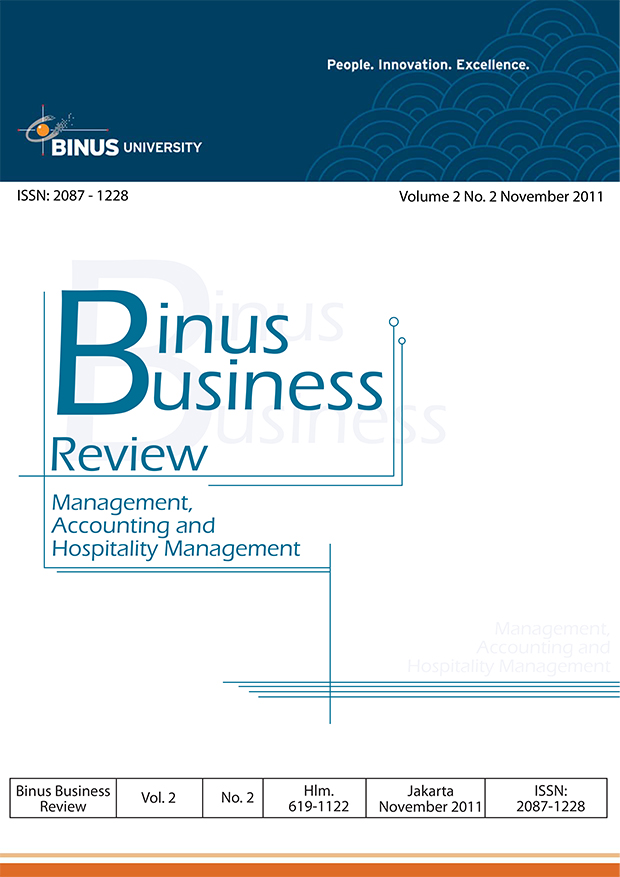Effect on Perceived Stimulation dan Perceived Crowding on the Decision of the Unplanned Purchase (Impulse Buying)
DOI:
https://doi.org/10.21512/bbr.v2i2.1223Keywords:
perceived stimulation, perceived crowding, impulse buyingAbstract
Purchase decisions aren’t made necessarily planned, because impulsive buying is such a result of environmental stimuli shopping. Things affecting unplanned purchasing decisions are perceived by stimulation and crowding. The purpose of this study is to determine whether there are influences between perceived crowding and stimulation of impulse buying simultaneously or partial. The object used is one of the largest retailers in Cilegon. This research design is quantitative analysis of the consumer unit. The collecting data technique includes using questionnaires, interviews, and literature from previous research. Data processed using the SPSS 16.0 program through the validity and reliability, normality test, and regression analysis. The study states that there is significant influence between perceived crowding and perceived stimulation both simultaneous and partial response to impulse buying.Â
References
Baker, W. E., & Sinkula, J. M. (1999). Learning orientation, market orientation, and innovation: Integrating and extending models of organizational performance. Journal orf Market-Focused Management, Vol.4, No. 4, pp. 295-308.
Bitner, M. J., Booms, B.H., & Tetreault, M. S. (1990). The service encounter: Diagnosing favorable and unfavorable incidents. Journal of marketing, Vol. 54, No. 1 (January), pp. 71-84.
Bitner, M. J. (1992). Servicescape: The impact of physical surroundings on consumer and employee. Journal of marketing, Vol 56, pp. 57-71.
Chandra, G. (2002), Strategi kepuasan pelanggan vs emosi pelanggan. Paper on Discussion Internal MARKLogic, unpublished, 19 October 2002.
Gronroos, C. (1990). Service management and marketing: Managing the moments of truth in service competition. New York: Lexington Books.
Keaveney, S. M. (1995). Customer switching behavior in service industries: An exploratory study. Journal of marketing, Vol. 59, pp. 71-82.
Kotler, P. (2002). Manajemen pemasaran. Jakarta:Prentice Hall.
Levitt, T. (1981). Marketing intangible products and product intangibles. Harvard business review,
May-June, pp.94-102.
Lovelock, C. H., & Wirtz, J. (2004). Services marketing: People, technology, strategy (5th ed.). Upper Saddle River, New Jersey: Prentice Hall.
Macheleit, K. A, Eroglu, S. A., & Mantel, S. P. (2000). Perceived retail crowding and shopping satisafaction: What modifies this relationship. Journal of consumer psychology, Vol. 9. No. 1: 29-42.
Mattila, A. S., & Wirtz, J. (2001). Congruency of scent and music as a driver of in-store evaluations and behavior. Journal of retailing (Vol. 77). 273-289.
Mattila, A. S. (2008). The role of store environment stimulation and social factors on impulse purchasing. Journal of services marketing, Vol. 22. No. 7: 562-567.
Mittal, B. (2004). Lack of attribute searchability: Some thoughts. Psychology and marketing, Vol.21, No 6, pp.443-462.
Parasuraman, A., Zeithmahl, V. A., & Berry, L. L. (1994). Alternative scales for measuring service quality: A comparative assessment based on psychometric and diagnostic criteria. Journal of Retailing, Vol. 70, No. 3, pp. 201-230.
Peter, J. P., & Olson, J. C. (2000). Consumer behavior: Perilaku konsumen dan strategi pemasaran. (D. Sihombing, terj.). Jakarta: Erlangga.
Riduwan, & Kuncoro, E. A. (2007). Cara menggunakan dan memaknai analisis jalur (path analysis). Bandung: Alfabeta.
Rossiter, J. R., & Percy, L. (1997). Advertising communications and promotion management. New York: McGraw-Hill.
Schiffman, L. G., & Kanuk, L. L. (2000). Consumer behavior (7th ed.). Upper Saddle River, New Jersey: Prentice Hall.
Sheth, J., & Parvativar, A. (1995). The evolution of relationship marketing. International business review, Vol. 4, pp. 397-418.
Soehadi, A.W., Hart, S., & Tagg, S. (2001). Measuring market orientation in Indonesia retail context. Journal of strategic marketing, Vol. 9. pp. 285-299.
Solomon, M. (1994). Consumer behavior (2nd ed.). USA: Allyn and Bacon.
Tendai, M., & Crispen, C. (2009). In-store shopping environment and impulsive buying. African journal of marketing management. Vol. 1. No. 4: 102-108.
Umar, H. (2003). Riset pemasaran dan perilaku konsumen. Jakarta: Gramedia Pustaka Utama.
Whiting, A. (2009). Push, scream, or leave: How do consumers cope with crowded retail stores? Journal of Services Marketing, Vol 23 No. 7: 487-495.
Downloads
Published
How to Cite
Issue
Section
License
Authors who publish with this journal agree to the following terms:
a. Authors retain copyright and grant the journal right of first publication with the work simultaneously licensed under a Creative Commons Attribution License - Share Alike that allows others to share the work with an acknowledgment of the work's authorship and initial publication in this journal.
b. Authors are able to enter into separate, additional contractual arrangements for the non-exclusive distribution of the journal's published version of the work (e.g., post it to an institutional repository or publish it in a book), with an acknowledgment of its initial publication in this journal.
c. Authors are permitted and encouraged to post their work online (e.g., in institutional repositories or on their website) prior to and during the submission process, as it can lead to productive exchanges, as well as earlier and greater citation of published work.
USER RIGHTS
All articles published Open Access will be immediately and permanently free for everyone to read and download. We are continuously working with our author communities to select the best choice of license options, currently being defined for this journal as follows: Creative Commons Attribution-Share Alike (CC BY-SA)





















